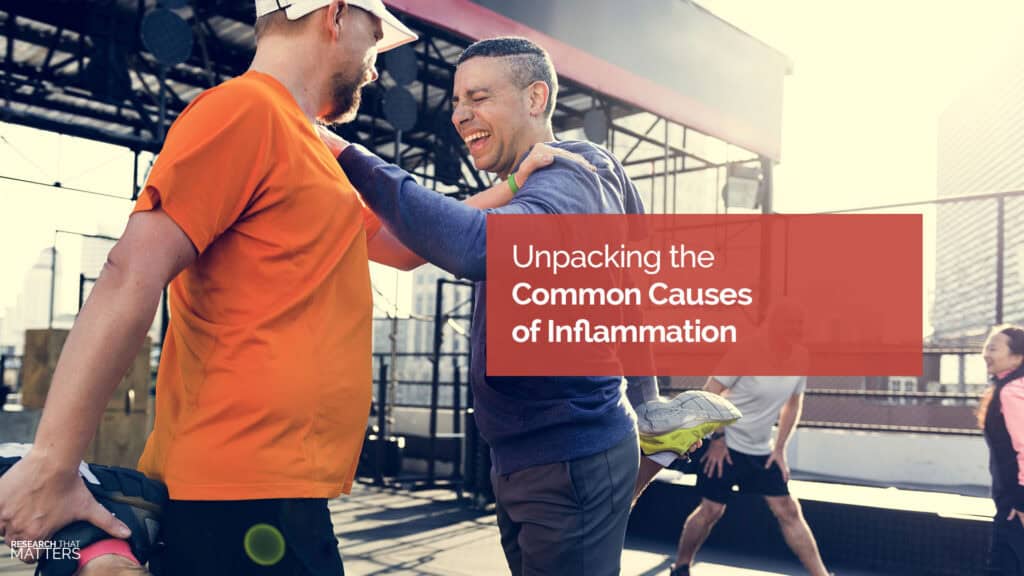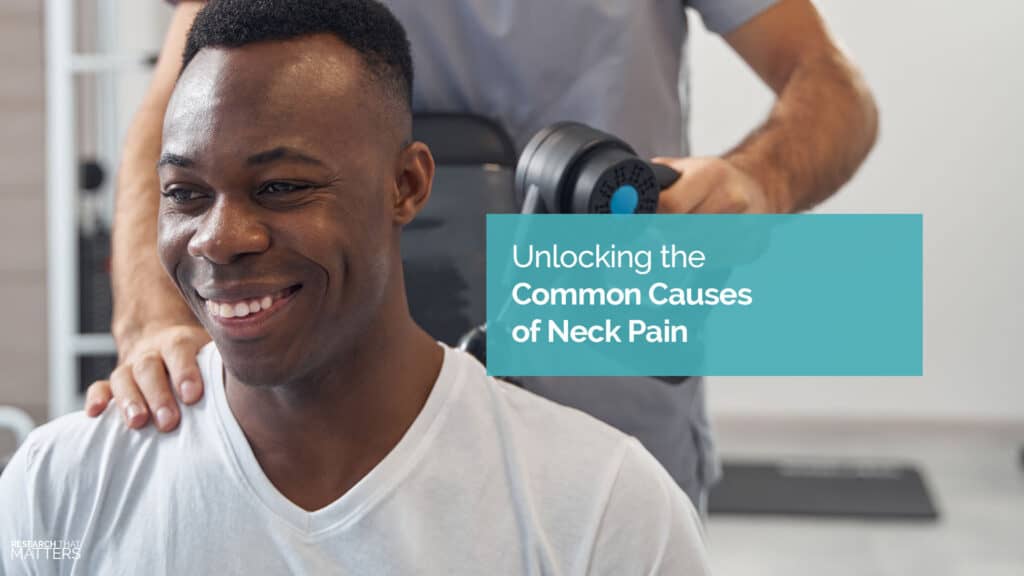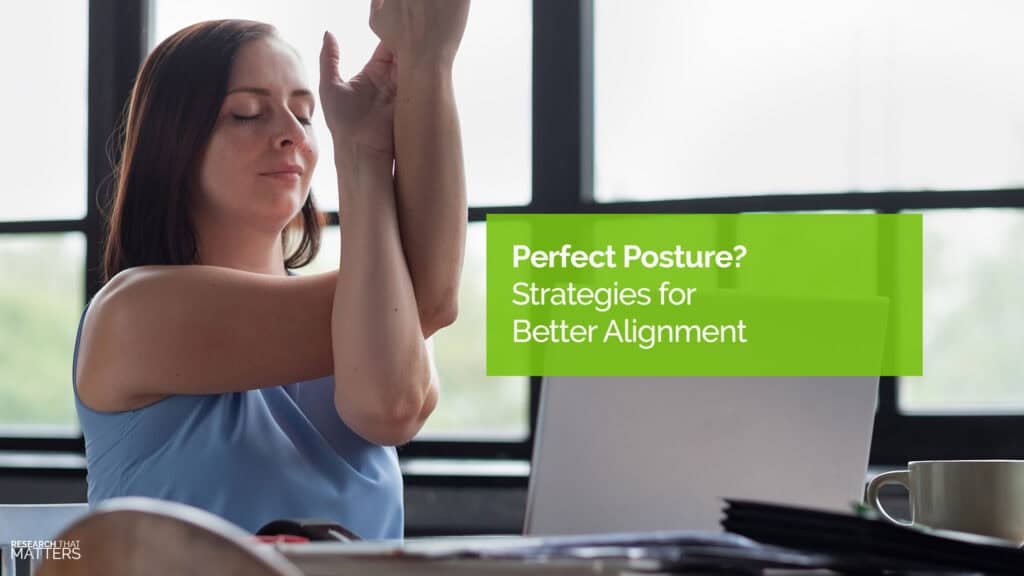Archive page
What Causes Inflammation?
Chronic inflammation is one of the most significant health issues many of us will face today. It’s been linked to everything from chronic pain to a wide range of other mild and serious medical conditions.
It’s important not to mistake acute inflammation for chronic inflammation.
Acute inflammation describes your body’s natural defense mechanism against injuries or toxins. When your immune system is constantly stressed, it can then lead to chronic inflammation which in turn can lead to other conditions.

Chronic Inflammation
In 2014, it was estimated that over 50% of people had at least one chronic condition, and 40% had more than one.
Chronic inflammatory diseases can include respiratory and heart disorders as well as diabetes. The majority of these disorders are linked directly to our lifestyle choices. Each day you have the option to either increase or decrease your state of inflammation.
Here are some fundamental ways to start taking your life back from chronic inflammation:
- Eat Fruits and vegetables are high in natural antioxidants and may protect the body against inflammation.
- Get enough Maintaining a regular sleep schedule can reduce your physical and emotional stress levels, which has been linked to a lower risk of chronic inflammation.
- Stay Exercise can lower the amount of pro-inflammatory chemicals in your body and benefit your cardiovascular and mental health.
Reducing your risk of chronic disease and inflammation begins with the choices you make each and every day, and we’re here to help you make the best decisions to help you live a full, active, and healthy life.
If you believe you’re not eating, sleeping, or moving as well as you would like, be sure you have an appointment scheduled with us. Together, we’ll analyze your habits and create a plan to get you and your well-being back on track.
Most Chronic Diseases are Linked to Inflammation
One of the most important health discoveries of the past 20 years has been that the immune system and inflammatory process are involved in nearly every mental and physical health problem we encounter today. It’s safe to say that chronic inflammation is a leading cause of chronic disease.
The Effects of Chronic Inflammation on the Body
Chronic inflammation is a condition that can affect your immune system and can influence all of your organs, tissues, and cells. Unlike the normal inflammatory response that happens after an injury and goes away within a few days, chronic inflammation is an abnormal response that can last years.
Here are just a few of the ways chronic inflammation can affect your body:
- Chronic inflammation can cause your immune system to function sub-optimally.
- Fatigue, increased blood pressure, insulin resistance, and poor appetite have also been linked to chronic inflammation.
- Heart disease and other neurodegenerative disorders have been linked to long-term chronic inflammation.
It’s true. It’s impossible to prevent chronic disease completely, but you have the power to reduce your risk every day. Taking action steps like eating right and exercising each day have been shown to dramatically decrease chronic inflammation and your likelihood of developing a chronic disease.
Know we’re here to help you live an active and fulfilling life. We understand that it’s hard to get enough exercise each day when you’re in pain. We hope you’ll take a moment to schedule a movement assessment with us so we can create a plan to help you start moving and feeling better.
Let’s take the first step towards reducing your risk of chronic disease together!
How Inflammation Affects Your Body
Inflammation is like a check engine light for your body. It tells you that something isn’t quite right, and you should pay attention.
The first step in discovering the cause of the problem is determining whether you have acute or chronic inflammation.
Acute inflammation is short-term and plays a critical role in healing and injury repair. Chronic inflammation on the other hand describes a condition where your immune system continues to produce white blood cells and chemicals even after the injury is gone.

The Signs of Chronic Inflammation
The combination of chronic inflammation and an excess of white blood cells can cause some problems for your immune system. In some cases, your immune system may even begin to target healthy cells and structures. If sustained over a long period of time, you may experience changes in your cells, tissues, and organs that can increase the likelihood of disease. Of course, one of the most significant challenges is that chronic inflammation can be invisible unless you know where to look.
Here are a few of the most common signs of chronic inflammation:
- Insulin Insulin helps control the sugar level in your blood, and inflammation could affect how well your insulin works.
- Muscle Chronic inflammation can cause your immune system to mistakenly attack and inflame your muscles, which could make you weaker.
- Fatigue is a sign of long-term inflammation and common in inflammatory diseases like fibromyalgia, multiple sclerosis, lupus, and rheumatoid arthritis.
If you’ve been living with muscle weakness, fatigue, or other nagging pains, you may also be living with chronic inflammation. It’s often your daily habits that contribute to this state of chronic inflammation.
Know that our team specializes in helping you create a healthy lifestyle through daily habits that combat chronic inflammation. We invite you to take the first step towards better health by scheduling your next visit with us today so we can work together to help you feel and function at your best.
How to Reduce Pain and Inflammation Naturally
While the inflammatory process is extremely complex, the solutions aren’t. Reducing pain and inflammation naturally is simple with the right strategy. Maintaining a healthy weight, eating a balanced diet, getting enough sleep, and exercising regularly are all ways that have been shown to effectively reduce pain and inflammation naturally.
Don't Wait to Get Care
Your diet and daily exercise routine play a huge role in managing chronic inflammation because each influences your weight and sleep patterns. Foods high in antioxidants (like berries, turmeric, green vegetables) can lower your overall inflammation and provide you with more energy. Daily exercise can help protect you against conditions such as heart disease and obesity, which have both been linked to chronic inflammation.
Did you know…
- Antioxidants known as polyphenols can lower inflammation.
- Even 20 minutes of daily exercise can have an anti-inflammatory effect.
- Proper sleep patterns encourage recovery and can lower stress and inflammation levels.
Reducing pain and inflammation naturally starts with your ability to move your body and exercise daily. If you notice an injury or pain is slowing you down, take a moment to schedule an appointment with us today.
Our expert team will work with you side by side to help you move better, and once you start moving better, everything else becomes easier! Give us a call. Let’s make chronic inflammation a thing of the past.
Is Inflammation Causing You Pain and Discomfort?
Call or schedule an appointment online and we can help you reduce your inflammation and finally let your body begin its healing journey.
Schedule an AppointmentContact UsWhy Does My Neck Hurt?
Your neck has a tough job. It has to hold, stabilize, and move the weight of your head every day for a lifetime. Holding up 11 pounds may not seem like a lot, but the seven bones and 20 muscles of your neck need to work together in perfect harmony for you to move your head around and keep that weight balanced. Postural changes, sudden injuries, and arthritis are a few of the primary causes of neck pain. Pain can often be traced to a problem with either the muscles, bones, discs, or nerves in your neck.

Respond Proactively to Your Pain
If you’ve ever been unable to turn your head for a day or two, you know how debilitating and life-changing neck pain can be. The sharp muscle spasms that restrict your ability to move can happen when your body tries to protect a spinal joint that isn’t moving correctly.
Almost every bone in your neck has a pair of sliding joints towards the back called facet joints. If an adhesion forms or the joint is stuck, your body will try to compensate or work around the issue for a little while. But, over time, this compensation can cause a cascade of additional challenges.
- Sudden injuries, arthritis, and postural issues can all contribute to neck pain.
- The small sliding joints (facet joints) of your neck can become stuck and cause muscles spasms and pain.
- Gentle spinal adjustments combined with daily stretching can help restore the motion of your facet joints and reduce pain.
Pain in your neck is your body’s way of saying “pain attention”! Even if it eases up by the end of the day, it’s a smart idea to have us evaluate your motion. Movement assessments are a part of our examination and provide us with an incredible amount of information about your body. By taking a proactive approach today, you may be able to prevent future episodes of neck pain and stiffness in the future.
Stenosis: How a Pinch in Your Neck Can Affect Your Whole Body
Have you been told that you have spinal stenosis? If so, you’re not alone. Millions of people suffer from spinal stenosis each day, and it’s the number one reason people over 65 years old have spine surgery. Spinal stenosis is the compression, or pinching, of your spinal cord. It can occur due to a disc herniation, bone spur, or ligament overgrowth. However, drugs and surgery are not the only way to find relief.
Take the Pressure Off
For many people, the most significant challenge associated with spinal stenosis is the decreased ability to get up and move! Severe pinching in your neck can cause issues with your arms and legs. One of the best ways to relieve the symptoms associated with spinal stenosis is to open up the spinal canal and take the pressure off the nerves and spinal cord. Many chiropractic techniques focus on decreasing the pressure on your spinal cord, relieving the symptoms associated with spinal stenosis.
- Spinal stenosis is a narrowing of the spaces within your spine, which can put pressure on the nerves that travel through the spine.
- Spinal stenosis is most commonly caused by degenerative changes in the spine related to osteoarthritis.
- Relief can often be found by building up your strength while improving the flexibility and stability of your spine with chiropractic care.
After chiropractic care, many patients report having a decrease in their symptoms, the ability to walk further without pain and find an improvement in their overall quality of life. If you have been slowed down due to spinal stenosis, do not hesitate to schedule an evaluation with us. We will provide a complete evaluation and guide you towards the best treatment options to find relief.
Is My Arm Pain Coming from My Neck?
Pain in your hand, wrist, or arm can be frustrating. You don’t realize how much you use your arms and hands until pain, numbness, or tingling gets in the way. Most of us don’t usually think that an issue in our neck may cause our arm pain. But it’s very common that arm pain can be traced back to a nerve issue in your neck.

Pinched Nerves Can Affect The Arms, Hands, and Shoulders
Hand, wrist, and arm pain often starts with a neck problem. When a spinal disc in your neck irritates or presses on a nerve, it can result in arm pain. Just like the power lines that bring electricity to your house, your brain and spinal cord split into individual nerve roots that deliver information to every part of your body. The nerves in your neck are specifically focused on providing strength and sensation to your head and arms.
- A bulged or herniated disc in your neck can irritate or compress the nerves that travel to your hands, arms, and shoulders.
- A recent study of people with cervical (neck) disc herniation showed improvement in over 86% of people who received chiropractic adjustments.
- Improving spinal mobility, decreasing inflammation, and improving your posture may help prevent future episodes of neck and arm pain.
A painful arm as a result of a pinched nerve in your neck very rarely requires surgery. Most people can find long-term relief with conservative care, such as chiropractic.
Getting rid of the inflammation and giving the disc time to heal are part of a complete plan we use each day to help our patients reduce their symptoms and get their lives back.
Neck Pain: How To Find Relief
An episode of neck pain can quickly hamper your everyday activities. Whether you began experiencing pain due to injury, degenerative spinal changes, or poor posture, it can be difficult to think about anything except the pain when you’re struggling. It’s estimated that 70% of people experience neck pain in their life, but you should know there is a path towards relief.
Small Adjustment. Big Changes.
Neck pain can create everything from headaches to pain in your arms and hands to pain directly on your neck. Different types of pain indicate different issues. The most common reasons for neck pain are strained muscles and stuck spinal joints. Each of these challenges can cause a lot of pain and may have you fearing that you have a more significant issue. But, with a proper examination, our team can pinpoint the cause of your pain and provide a complete plan of care to help you reclaim your life from neck pain.
- Facet joints are small spinal joints at the back of your spine which can become fixated or stuck and cause pain.
- Muscle strains can occur due to poor posture at your desk or sleeping in an awkward position.
- Motion heals: relief typically begins by reducing the inflammation and improving your range of motion.
A small adjustment can make big changes in your quality of life. Our practice is focused on helping you feel (and function) better by improving your spinal motion and then providing you with the stretches and exercises you can do at home to continue your improvement. If neck pain has got in the way of you enjoying your life- give us a call. Our team is here to help.
Science Sources:
Intervertebral Kinematics of the Cervical Spine. The Spine Journal. 2018.
Spinal Stenosis. The Mayo Clinic. 2022.
Cervical Nerve Root Injections or Spinal Manipulative Therapy. JMPT. 2016.
Spinal Manipulation, Medication, or Exercise. Annals of Internal Medicine. 2012.
5 Healthy Habits That Prevent Chronic Disease. Cleveland Clinic. 2020.
Suffering from Neck Pain?
Call or schedule an appointment online to see how we can help ease your neck pain and begin your journey of healing.
Schedule an AppointmentContact UsPerfect Posture is Dynamic
Is there such a thing as perfect posture? The answer may surprise you. The latest research shows that it’s actually more beneficial to think about your posture as dynamic, not static. In other words, your ideal posture is constantly changing and evolving.

The Negative Effects of Poor Posture
Think of your posture as a dynamic pattern of responses, reflexes, and habits–not just as a fixed position.
Gravity, your work environment, and your body’s anatomy all play essential roles. For instance, sitting for hours at a time staring at a computer screen is a perfect example of a damaging static posture that over time can lead to the development of chronic forward head posture.
Forward head posture affects millions of people who spend their days using computers and has the potential to cause pain and degenerative changes in your spinal joints. It places stress on the neck and shoulders and weakens the supporting muscles.
Here’s what you need to know:
- Forward head posture affects millions and results in neck pain for up to 75% of those affected.
- Neck pain, tension, stiffness, and tenderness are all signs of chronic forward head posture.
- Trapezius strengthening has been shown to provide clinically significant relief for those struggling with neck pain as a result of forward head posture.
If you spend long hours each day in a single position (such as sitting at a computer) it’s important to take the time to take periodic breaks to stretch and move your body.
Remember, posture is dynamic, and stretching can help not only “reset” your posture, but also help keep your spine healthy and your energy levels up!
Scheduling a posture and movement assessment with us is also a smart idea to help ensure you remain as pain-free as possible no matter how you spend your days. Just give us a call!
How to Improve Your Posture
When discussing posture, we’re often referring to the overall position of your body as you stand, sit, or lie down.
Most experts would agree that a “good” overall posture involves physical positions that reduce stress on the body by balancing the load placed on the muscles and ligaments that support the spine.
If you’ve looked in the mirror and noticed that your posture doesn’t look as balanced as you’d like–not to mention, doesn’t feel as balanced as you’d like–you may be wondering what you can do to improve it.
Healing Through Motion
One of the best ways to improve your posture is through motion.
Changing positions frequently during the day, stretching, and specific postural exercises are all ways to improve your posture.
Good posture helps you keep your bones and joints in proper alignment, which helps reduce the wear and tear on your joints and decrease the strain on the ligaments that support your spine.
Here are some key takeaways:
- Good posture means keeping your spinal curves aligned and weight evenly distributed.
- Stretches and exercises can help improve your posture and reduce your risk of neck and back pain.
- Standing desks have been shown to reduce back pain by over 30% when compared to sitting at a desk.
When creating a plan to improve your posture, remember that stretching and exercising are essential. Equally important is knowing where to start.
Our postural and movement assessments can help you determine the best strategy to help balance and improve your posture, especially if you’ve been living with pain.
How Your Smartphone Impacts Your Posture
Believe it or not, many of us spend 3 hours or more per day on our smartphones. That adds up to over 1,000 hours each year! And the positions we tend to hold our heads in while using our devices can be, well… damaging. Damaging to your posture, and damaging to your spine. It’s not surprising that over the past few years, an uptick of these awkward positions has led to an uptick in head and neck pain.

"Tech Neck"
It’s estimated that tilting your head forward, even just 15 degrees, can triple the weight of your head on your neck. In fact, tilting your head forward 60 degrees can increase the stress and strain on your neck ten times over.
Repeating this forward head posture again and again over time can result in pain, stiffness, dysfunction, headaches, and more–a group of symptoms often referred to as “Tech Neck.”
The good news about postural stress and “Tech Neck” is that a few simple changes to your routine can help you reduce your risk of experiencing pain.
Here’s what you need to know:
- “Tech Neck” is the term used to describe the flexed head and neck position that occurs when looking down at your smartphone.
- Just 15 degrees of forward bending can increase the stress of your head on your neck three times over.
- Taking breaks every 15 minutes and looking up from your phone or tablet can help your body reset and give your muscles a chance to relax.
Know that reducing your “Tech Neck” symptoms involves more than just changing the angle you look at your phone. Proper ergonomics and regular stretching and exercise all play significant roles in helping you continue to enjoy your favorite devices without those nagging pains.
If you’ve been living with “Tech Neck” and are ready to take action, you’ve come to the right place! Our expert team is ready to not only help evaluate your ergonomics, but to also provide a plan of action complete with personalized recommendations that will help make it easy for you to maintain a more balanced posture for years to come.
Posture: Balancing Strength and Flexibility
Both strength and flexibility play a significant role in how your posture develops.
For instance, having both a strong and flexible core helps the body to dynamically adapt to every environment. The spine is not only supported but also moves well, reducing the possibility of injury or pain. While it’s true that “perfect” postures may not exist, improving our strength, flexibility, and ergonomics goes a long way towards improvement.
Don't Wait to Get Care
Your body is dynamic, and it’s designed to move, but over time it may feel a bit less dynamic than it used to!
Getting into a wellness routine that includes exercises that focus on strength and flexibility is a smart way to keep your body feeling young while promoting good posture–a true win-win.
Here’s why:
Strengthening exercises can help develop proper support for your joints and decrease overall postural stress. Incorporating stretches and exercise that focus on flexibility then help you body maintain the ability to move through its full range of motion.
Did you know…
- When you focus on increasing muscular flexibility, your posture is likely to improve.
- Lifting weights strengthens your back, shoulder, and core muscles, which are all essential to standing with proper posture and preventing lower back pain.
- Stretching your muscles and joints also leads to a greater range of motion, improved balance, and increased flexibility.
Remember, postural stress can add up over time. Just because you’re not currently in pain doesn’t mean that everything is functioning at its highest level or that your daily wellness routine is as optimized as it could be.
Our team specializes in all things posture and providing comprehensive individualized care plans – adjustments, stretches, exercises, and all!
Schedule an appointment today if you’d like to learn more about all the ways we’re helping the people in your community achieve an ideal balance of strength and posture and flexibility. Our doors are open, and we’re here for you.
Science Sources:
Effects of Trapezius Strengthening on Posture. Med Sci Monit. 2020.
Back Health and Posture. Cleveland Clinic. 2020.
“Tech Neck” Taking a Toll on Posture. Columbia Spine. 2018.
Breaking up Workplace Sitting Time. Occup Environ Med. 2014.
Why Being Flexible is Great for Your Health. Healthline. 2020.
Forward Head Posture and Neck Pain. Curr Rev Musculoskel Med. 2019.
Guide to Good Posture. Medline Plus. 2023.
Upright Posture Improves Affect and Fatigue. J Behav Ther Exp Psychiatry. 2017.
Wondering How to Effectively Improve Your Posture?
Let us help! Call or schedule an appointment online to see how we can help improve your posture, decrease your pain, and live a better, healthier life.
Schedule an AppointmentContact UsBe Smart With Your Smartphone and Look Up!
As students worldwide return to school, it’s likely many will be e-learning in some capacity for hours each day on their digital devices. While our devices can be fantastic tools for entertainment and education, the postural effects are something all parents should be aware of. For many students, e-learning may increase neck, mid-back, and low back pain.
How Digital Devices Can Affect Your Health
Spending 6 or more hours each day looking down at your digital devices can profoundly affect your mental, social, and physical health. It can also lead to the development of “Tech Neck Syndrome.” This forward head posture often places tremendous stress on the neck (cervical spine) and can lead to an uptick in headaches, back and neck pain, and more.
Did you know…
- Low back pain is the 3rd most common form of pain interfering with schoolwork.
- It’s estimated that 50.3% of school-aged children present with posture disorders.
- In fact, approximately 6% of children experience back pain from prolonged sitting.
Making it a habit to look up (literally!) throughout the day is a significant first step in reducing the effects of “Tech Neck.” Try this. Pull your chin back, stretch your arms out in front of you and open them wide, and look up to the ceiling and hold for 20-30 seconds. Try and repeat this stretch every 60 minutes to help reset your posture and body position. And if your child spends every day at their computer learning, be sure to teach them this stretch and then schedule a visit with our practice. We’ll provide you with a full postural and movement-based assessment to identify any potential issues to help reduce their chance of suffering from “Tech Neck Syndrome.”

Why Chiropractic Care is Critical for Kids Who Play Sports
Youth sports are a big deal. It’s estimated that over 45 million kids are actively engaged in sports! While sports give kids a fantastic opportunity to grow socially and physically, they also increase risks for injuries, pain from overuse, and muscular imbalances. Finding proactive ways to reduce the risk of injury and balance the effects of training are essential for your child’s developing musculoskeletal system.
Ensure Proper Musculoskeletal Development
Your child’s skeletal system is actively developing until they are approximately 25 years old. Their postural habits, history of injuries, and genetics play a role in their body’s final form (and function). Sports have the potential to add a significant amount of stress and increase the chances of injuries for your developing child. Even small injuries to their spine can create bigger challenges down the road as they get older.
To recap:
- Addressing minor injuries and challenges while your child is young can help ensure proper musculoskeletal development.
- Youth sports can increase your child’s likelihood of developing overuse, growth plate injuries, and chronic pain.
- Chiropractic care is a safe and natural way to help your child stay active and perform their best.
Remember, don’t shrug it off if your child complains of back pain, headaches, or a stiff neck. Pain is a signal to “Pay Attention Inside Now.” The good news? Our practitioners are experienced at evaluating active children and creating kid-friendly care plans. Together, we can help your child stay engaged with their favorite sports for years to come.
Power Your Child’s Brain with Movement
Years ago, many believed that the health benefits of exercise were limited to the body. However, research has demonstrated that regular physical activity and movement can benefit both the body and the brain. Recent studies have highlighted that movement can improve the supply of oxygen to the brain and promote the production of new cells. In fact, it appears movement also aids in creating new connections in the brain!

The Benefits of Daily Movement
Many schools have reduced physical education classes. Many more students have moved towards e-learning. For those reasons, it’s important to be mindful of our children’s physical activity and to encourage them to exercise more each day. And not just to benefit their physical health. In many ways, exercising each day is likely to make your child a better student! Movement triggers the release of chemical substances in the brain that enhance brain function.
Here’s a quick snapshot of the benefits of movement:
- Better Brain Function – Movement may protect your brain against degenerative changes.
- Better Stress Reduction – Exercise and movement have been shown to have an antidepressant effect that can help reduce overall stress.
- Better Memory – Regular exercise can help directly and indirectly improve recall and reasoning skills.
The research is clear. Daily movement and exercise are healthy for both your child’s body and their brain. And our posture and movement assessments are designed to help you identify any abnormal patterns, helping your child feel better and stay active so they can become the best student possible. So, if your child struggles to get enough exercise due to nagging aches and pains or less than ideal posture, we hope you’ll consider scheduling an appointment with us today. Our doors are open, and we’re here to help!
E-Learning: How to Avoid Tech Neck
Is your child connected to a phone, computer, or tablet during and after school? Think about it. Many of us aren’t more than an arm’s length from our phone at any time (even when we are sleeping). Spending time every day looking down at our devices can place a lot of stress on the supporting muscles of our neck and lead to an uptick in headaches. It’s a condition called “Tech Neck,” and it’s one of the most common causes of headaches and neck pain.
Don't Wait to Get Care
The countless hours per day kids often spend on phones and computers can significantly contribute to tension headaches. In fact, it’s estimated that kids spend up to 1,400 hours per year in the exact positions that are attributed to the development of “Tech Neck.” That’s not surprising. Recent research has also shown that even 15 degrees of forward head tilt can triple the weight of the head on the spine.
Here are some key things to remember when it comes to “Tech Neck”:
- “Tech Neck” is the term used to describe the symptoms of headaches, neck pain, and poor posture attributed to the forward head posture often associated with using your phone, tablet, and
- Taking a break from our mobile devices every 15 minutes can help reduce the likelihood of developing recurring neck pain and headaches.
- Chiropractic care including adjustments and postural exercises can help decrease the pain and reverse the effects of “Tech Neck”.
Keep it simple. Encourage your children to take breaks and stretch often. These are some of the best (and easiest) ways to help them break the bad habits that can lead to “Tech Neck.” And if your child spends alot of time online and begins experiencing neck pain or headaches, don’t hesitate to give us a call. Our providers are experienced at evaluating children and creating kid-friendly care plans. Our doors are open, and we’re ready to help you and your family find long lasting, natural relief from “Tech Neck.”
Science Sources:
Text Neck Syndrome. Intl Journal of Env Research and Public Health. 2021.
Three Steps to Build a Better Back. Harvard Health Pub. 2015.
Back Pain in School Children. Dynamic Chiropractic. 1995.
School Children’s Backpacks, Back Pain and Back Pathologies. Arch Dis Child. 2012.
Backpack Safety: It’s Time to Lighten the Load. National Safety Council. 2020.
Specialization & Overuse Injuries in Young Athletes. UCONN Health. 2017.
Learning Upregulates Neurotrophic Factor. Behavioral Neuroscience. 2019.
The Anti-Depressant effect of Running. Intl Journal of Neuropsychopharmacology. 2005.
Regular Exercise Changes the Brain. Harvard Health Pub. 2014.
How Exercise Affects Your Brain. Scientific American. 2018.
Assessment of Stresses in the Cervical Spine caused by Posture. Surg Tech Intnl. 2014.
Help Keep Your Children Healthy
Is your child suffering with neck or back pain? Call or schedule an appointment online to see how we can help.
Schedule an AppointmentContact UsWhy are Opioids so Dangerous?
It’s estimated that over 200 million opioid prescriptions are written each year. This use and abuse has led to an epidemic that’s been fueled by chronic pain. Opioids temporarily hide pain by attaching to receptors in the brain and boosting feelings of pleasure. Unfortunately, they do nothing to stimulate healing, leading to a pattern of pain, medications, more pain, and more medications. The good news is that there is a better way to find relief.

The Addictive Nature of Opioids
Opioids are in the same family of drugs as heroin, and some opioid medications are thought to be even more addictive. The temporary relief that they offer comes at a steep price. In lower doses, opioids can cause drowsiness or dizziness. In higher doses, they can cause your breathing and heart rate to slow down to dangerous levels. But the most dangerous aspect of opioids is the addiction rate of up to 30%.
- Opioids bind to the receptions in your nervous system that block pain and produce intense euphoria.
- Tolerance on opioids can occur within a matter of days.
- Withdrawal symptoms are severe and can lead to addiction.
Nearly all the latest healthcare guidelines have stopped recommending opioids for non-cancer pain. In most cases, these drugs should not be taken for chronic pain or back pain. To find relief without these dangerous drugs, call us today. We’ll schedule a complete evaluation to discover the cause of your pain, then find ways to help you get back on your feet.
Finding Relief Without Opioids
There is no question that opioids are powerful pain killers. The problem is they are also highly addictive and don’t actually fix the cause of your pain. But, if you’re struggling with chronic pain, you may be curious what your best options are for care. How can you fix the cause of your pain, find lasting relief, and avoid these harmful medications?
Lasting Relief and Healing through Chiropractic
You may be surprised to discover the people who saw a chiropractor for spine pain had half the risk of filling an opioid prescription than those who didn’t. It’s not just that chiropractors don’t prescribe these dangerous medications. As time went on, people were not likely to fill an opioid prescription. That indicates the care provided by chiropractors helped people find enough relief that they no longer sought medications to find relief!
- Choosing chiropractic for spinal pain can reduce your risk of filling an opioid prescription by over 50%.
- Masking spine pain with medications can possibly increase your risk of further injury.
- Movement-based care helps the body heal and can improve your likelihood of finding long term relief.
Opioids aren’t meant to treat chronic spinal pain. They don’t help your body heal and become less effective at stopping pain the longer you take them. Instead of building up a tolerance and putting yourself at risk for dependence, it’s a smart decision to explore other treatment options. Call us today to schedule an evaluation so that we can create a personalized treatment plan for you! Our practice is proud to help our community find relief from pain without the need for drugs.
Exposing the Truth Behind Opioids
The truth will set you free. While much of the information about how the opioid epidemic is shocking, it’s important to understand how we got here. For example, when we first learned that 35 billion opioids (half of all the distributed pills) were handled by about 15% of pharmacies, it became clear that there was a network of “pill mills” that weren’t concerned about helping people actually find relief from their chronic pain.
A Dependence on Opioids
Chronic pain is a real issue for tens of millions of people each day. In many of these cases, the answer isn’t found in a pill but rather with a combination of movement-based treatments. Your body heals through motion. Taking medications may provide temporary relief, but they don’t address the cause of your pain.
Nearly everyone who takes opioids for an extended time becomes dependent. We think it’s a smart idea to avoid the risks.
- In 2016, over 91 million people used prescription opioids.
- The rates of emergency department visits involving opioids more than tripled from 1999 to 2013.
- Over 16 million people currently suffer from an opioid use disorder.
In the 1990’s medical doctors were falsely lured into prescribing opioids as a treatment for pain. Aggressive marketing of the drugs downplayed the risks, and prescriptions for mild to moderate pain were continued indefinitely, with no intention of tapering off. This combination has led to the epidemic we are in today. But there is a solution. The first step is having the right information about opioids and chronic pain. The next step is to connect with a movement-based practice, like ours, to discover how you can find long-term relief without these dangerous medications.

Taking a Stand Against Opioids
About 30 years ago, medicine had a shift in how they thought pain should be addressed. “Pain is a 5th vital sign” became a rallying cry, and new medications were created to block pain…at all costs. They now know that these medications created a never-before-seen healthcare epidemic. To begin with, the drugs weren’t very good at addressing chronic pain, and they require larger and larger doses to achieve an effect over time.
Don't Wait to Get Care
Taking a stand against opioids starts with our ability to help people find relief from chronic pain. Nearly all of our primary healthcare organizations have now advocated for a non-drug approach to care. And the data is clear–people are looking for solutions for chronic pain that extend beyond a prescription.
- The Centers for Disease Control (FDA), Food and Drug Administration (FDA), and others have recommended a non-pharmacological approach to chronic pain should be the first line of treatment.
- Over 40% of blogs relating to opioids are focused on people trying to find solutions “beyond the pill.”
- Together, we can end the opioid crisis by breaking the cycle of chronic pain with natural and effective healthcare choices.
Chronic pain is described as biopsychosocial, which means that it’s complex and has many dimensions. Creating personalized care, goal-oriented, and coordinated care plans are critical and exactly why our practice begins each patient with a complete and thorough evaluation. Our evaluation helps us understand your history, your goals, and your current challenges. From there, we can create a comprehensive plan of care that enables you to find long-term relief from chronic pain.
Looking for an Alternative to Opioids?
Call or schedule an appointment online to see how chiropractic can help relieve pain and facilitate healing.
Schedule an AppointmentContact UsHow to Find Shoulder Pain Relief
Your shoulder is the most unstable and moveable joint in your body. Its wide range of motion occurs due to four primary muscles and their tendons, which together are called the rotator cuff. If your shoulder becomes inflamed or an impingement happens, you may make the mistake of trying to avoid using your arm to help it heal. It may surprise you to learn that not moving can actually contribute to more pain or even lead to a frozen shoulder. Controlled movement is one of the best ways to heal.

Common Causes of Shoulder Pain
The most common source of pain in the shoulder is the tendons. Your tendons attach the muscles of the shoulder to the bones. If a tendon becomes trapped, it can result in shoulder impingement. If a tendon becomes inflamed, you may hear it referred to as tendinitis or bursitis. And if a tendon becomes torn, you guessed it; you have a rotator cuff tear.
- Shoulder Bursitis: If the sac of fluid that cushions your shoulder becomes swollen and painful due to repetitive motions, you may have bursitis.
- Shoulder Impingement: If your tendons get pinched between or under the bones of your shoulder, it can lead to Lifting overhead repetitively can cause impingement, and it can result in swelling and pain.
- Rotator Cuff Tear: Your rotator cuff can become damaged due to overuse, injury, or Tears usually cause pain when you try to lift things, and you may hear a popping sound as you move.
Your shoulder and spine work together. While it may seem like they are two completely different areas, it’s been discovered that postural abnormalities can play a significant role in your likelihood of developing shoulder pain. Maintaining a full range of motion in your shoulder and spinal joints of your neck and mid-back can help reduce your chances of dealing with shoulder pain. If you notice shoulder discomfort or restricted movement, contact us for a complete evaluation. We’ll work to create a movement-based plan to help you find long-term relief.
Your Hip vs. SI Joint: What's the Difference?
It can be extremely confusing to figure out the difference between hip and SI (sacroiliac) joint pain. But being able to identify which one is the culprit is crucial when you are looking to find relief. Your SI joint is the connection between your tailbone (sacrum) and your pelvis. The SI joint is very fibrous and only moves a few millimeters. On the other hand, your hip is much less stable and allows your entire leg to move in every plane of motion.
Similar Pain, Different Sources
While the hip and SI joints are very different in structure and function, they share similar pain patterns, making it difficult to tell one from the other. It’s common to have SI joint pain mimic low back pain. Bending backward usually aggravates SI joint pain due to the compression that happens in the joint as you move.
Hip pain is more likely to occur when you walk or if you try to bring your knees to your chest.
- Hip Pain: Characterized by pain with walking, weight-bearing, and rotating the
- SI Joint Pain: Difficulties while standing, walking, climbing stairs, getting out of the
- Low Back Pain: Pain that radiates into the buttock or leg and may travel down to the
Suppose you’ve felt discomfort and aren’t exactly sure if it’s your hip, SI joint, or low back. It’s important to find a chiropractor who will provide a complete evaluation and treatment plan. The reason this is important is that our hips tend to become degenerative as we age, and if your doctor is only looking at a hip X-ray to determine a plan of care, you may find yourself getting treatment for a problem you don’t have. We take a holistic approach to our evaluations, and our movement assessments ensure that we can pinpoint your challenges so that you get the best care plan to live your highest quality of life.
Are You at Risk for Chronic Knee Pain?
Knees hurt? You’re not alone. Chronic knee pain is thought to affect up to 25% of adults and can significantly limit your mobility and quality of life. Your knee is a hinge-joint that primarily moves back and forth (flexion and extension) and allows some twisting or rotation. Every step you take places stress and strain on your knees, so it’s no surprise that trauma, misalignment, and degenerative changes can all take their toll.

Steps You Can Take to Reduce Knee Pain
While knee pain may not be entirely preventable, there are steps you can take to keep your knees as healthy as possible. At the top of the list is to watch your weight. For every pound you are overweight, your knee must absorb an extra 4 pounds of pressure when you walk, run or climb stairs. In addition, the cartilage in your knee is designed to last a lifetime if you take care of it.
Here are a few additional ways to keep your knees healthy and strong.
- Warm-Up Before Exercising: Stretching your quadriceps and hamstrings before and after you exercise is a smart way to reduce the chance of a flare-up of knee pain.
- Find Adequate Foot Support: Every step you take transfers force from the bottom of your foot to your knee. Therefore, your shoes should provide the support you need to keep your knees healthy for at least 10,000 steps per day.
- Maintain a Full Range of Motion: Ensuring your low back and hips are moving freely is essential to overall knee health.
The joints of your body should have a balance of strength and flexibility through their full range of motion. Unfortunately, it’s not uncommon for people with back issues to find themselves struggling with knee pain after limping around for a few weeks. We encourage our patients to be proactive with their health. Use the strategies above to help reduce your chances of knee pain, and be sure to call our practice if you notice any pain or restricted motion.
Tennis Elbow? But I don't even play tennis!
Tennis elbow isn’t just for athletes. Lateral epicondylitis (tennis elbow) is a painful condition that occurs when the tendons in your elbow are inflamed and overloaded due to repetitive motion. Because of the motion that occurs when swinging a racket, it’s commonly referred to as tennis elbow, but anyone who has a job that features repetitive arm motions may be at risk.
How to Reduce Tennis Elbow Pain
Tennis elbow can become a serious issue because of the pain and weakness that make it difficult to perform your daily tasks. Because it’s an injury caused by repetitive motions, and since many of these motions are essential to your job, finding ways to decrease the inflammation and improve biomechanics is critical. Three natural ways to help reduce the pain associated with tennis elbow include:
- Rest: Giving your arm time to rest is important to stop the cascade of inflammation and pain.
- Ice: Icing, a few times per hour, is a smart strategy to reduce pain and inflammation.
- Technique: Be mindful of how you are moving your arm, use proper ergonomics, and use a brace for a short time if necessary.
Tennis elbow is usually not a condition that will go away on its own. However, we’ve found two key strategies for reducing the pain associated with tennis below. First is receiving a plan of care that includes at-home exercises to strengthen your supporting muscles. The second is receiving adjustments, when necessary, to improve the motion and movement of your elbow joints. If you or someone you know has struggled with tennis elbow, give us a call so that we can provide you with a plan to find relief.
Suffering with Shoulder, Hip, or Elbow Pain?
Call or schedule an appointment online to see how we can help reduce your pain and help your body begin healing.
Schedule an AppointmentContact UsWhat Type of Headache Do You Have?
Over 90% of people will have at least one headache in their life. For some, occasional headaches can turn into a daily occurrence that disturbs both work and hobbies. In many cases, headaches aren’t associated with a disease but are instead a result of your daily habits and actions. The most common triggers for a headache include stress, fatigue, lack of sleep, hunger, and caffeine withdrawal.
Tension, Sinus, and Migraine
Being aware of the type of headache you have and its triggers is the first step towards finding relief. Stress is a primary cause of all types of headaches. It’s important to remember that stress can be mental or physical. Physical stress can include muscle tension in your shoulders, head, and neck that commonly occurs due to long hours at the computer, unbalanced posture, or a lack of regular exercise.
The three most common types of headaches include tension, sinus, and migraine headaches.
- Tension Headaches: Usually felt across the forehead and last a few hours.
- Sinus Headaches: Typically occurs in the face, lasts a few hours, and is seasonal.
- Migraine Headaches: Pain in the back of the head, temple, or eye that lasts a day or longer and can produce sensitivity to light and sound.
Now you’ve identified the types of headaches you are usually affected by, you can begin taking proactive steps to reduce your risk. Getting enough rest and watching your caffeine intake is a good start. Research has also found that spinal adjustments are effective at reducing the frequency and severity of headaches. If you’ve been suffering from headaches, reach out to discover if we can help.

The Link Between Neck Pain and Headaches
Your head hurts. Could it be coming from your neck? You may be surprised to learn that neck pain and headaches are tightly linked together. A headache that starts from an issue in the neck is called a cervicogenic headache. A cervicogenic headache is characterized by a dull pain that radiates from the neck to the back of the head. At times it may spread around the side or front of your head.
Cervicogenic Headaches
Cervicogenic headaches are common if you spend long hours at the computer each day. Neck stiffness and tender muscles around your head and shoulders often come along with cervicogenic headaches because of the position that many of us sit in all day. The added stress and strain on your upper back and neck muscles can add up over time and begin to cause occasional headaches. Without taking proactive steps to address the cause of the issue, you may notice that the headaches become more frequent and intense.
- Cervicogenic headaches can begin due to tightness in the shoulders, a stiff neck, or poor posture.
- Over 70% of people with cervicogenic headaches find significant relief with spinal adjustments.
- Spinal adjustments can reduce the severity and frequency of headaches.
To break the cycle of daily cervicogenic headaches, you need to address the underlying cause. Staying well hydrated (with water!), stretching at least every hour, and setting your workstation up ergonomically are all important to reduce your headache risk. If you still notice that headaches are bugging you, have pain, or limited neck range of motion, call us for a complete evaluation and plan of care to get well and stay well.
How to Get Rid of Daily Headaches
If you notice that your headaches are becoming more frequent and intense, it can be troubling. Daily headaches can make it challenging to have a high quality of life and can affect your work and home life. The good news is that many of the most common types of headaches can be reduced or even eliminated by changing just a few of your daily habits.

Stress and Tensions
Stress and tensions are two of the biggest triggers for tension headaches. Chronic headaches can cause your nervous system to become sensitized. That means each day it takes less “stimulus” to kickstart a headache. Sensitization can become a vicious cycle, especially if your days are filled with repetitive motions. One of the best ways to reset your system and decrease sensitization is through movement. Whether you prefer yoga, stretching, or massage, movement of your spine and body can ease the tensions associated with headaches.
Symptoms of Tension Headaches include
- Dull, aching pain in the head and neck.
- Pressure and tightness across the sides, front, and back of your head.
- Tenderness in your shoulders, head, and neck.
Movement and exercise are key to life and one of the most powerfully simple ways you can break a cascade of daily headaches. If you’re struggling to get moving because of the pain, let us know. We’re happy to work with you to develop a comprehensive plan to help you reduce the frequency and severity of your headaches starting today.
Headache Medications Cause Headaches
One of the primary side effects of many prevalent headache medications is, well…more headaches. That’s right; rebound headaches are caused by taking the same medications used to find relief. If that sounds bizarre, it is. Even taking medications more than just a few days may trigger overuse, or rebound, headaches.
Establish Healthy Habits
Taking care of yourself and creating healthy habits each day can prevent most headaches. If you find yourself reaching for over-the-counter pain medications more than once per week, you may be putting yourself at risk for rebound headaches. Most headache medications aren’t designed to be used frequently because they simply address the symptoms, not the cause of the problem. As you take medication, your body can become sensitized, meaning you need to take more medication to achieve the same result. This can lead to a downward spiral and cycle of chronic rebound headaches.
Here are a few ways to naturally reduce your risk of headaches.
- Get Enough Sleep: Going to bed and waking up at the same time each day helps your body maintain a natural rhythm.
- Reduce Your Stress: Plan, manage your daily schedule, and make stress-busting activities like yoga or meditation a part of your lifestyle.
- Exercise Regularly: Movement and exercise releases endorphins that help your brain and body feel good and block pain signals to your brain.
Medications aren’t very effective at reducing the frequency or severity of headaches. Masking the symptoms with drugs can work now and again, but it’s not a sustainable way to find long-lasting relief. To find last relief, you’ll want to follow the latest healthcare guidelines that recommend movement-based care, such as chiropractic. We believe everyone should have the opportunity to live their life free from chronic headaches.
Sources:
Chiropractic Therapy for Migraine. Eur J Neurol. 2017.
Spinal Manipulation for Chronic Headache. Spine J. 2010.
Chiropractic Therapy for Headache. BMC Res Notes. 2017.
Manual Therapy Effect on Tension Headache. Eur J Phys Rehabil Med. 2016.
Tension Headache. MedlinePlus. 2019.
Start Feeling Better Today!
Schedule a complimentary consultation to see how we can help relieve your headaches.
Schedule an AppointmentContact UsStaying Healthy as a Weekend Warrior
Millions of people participate in sports each weekend as a way to stay active and stay connected to their friends. Inevitably as we age, the likelihood of an unexpected injury creeps up; so how can you stay healthy as a weekend warrior? You may be surprised to learn that the proactive steps you take during the week to stay well will directly impact your ability to keep enjoying your weekend sports.
The Benefits of an Active Lifestyle
Weekend sports such as a softball game may last a few hours. If you enjoy hiking or mountain biking, you may be looking at 4-6 hours of sports activities each weekend. Either way, it’s a short amount of time compared to the number of hours you spend working each week. That is why taking daily, proactive steps with your health are so important. Stretching to improve your mobility, strengthening to improve your support, and moving through your entire range of motion can help you feel more energized each day and potentially reduce your risk of injury on the weekends.
- Weekend warriors have a 40% lower risk of death due to cardiovascular disease.
- At least 75 minutes of vigorous exercise is recommended each week.
- Regular exercise during the week may help reduce your risk of injury on the weekends.
Building a new health habit takes time. Using your smartwatch or a health app is a great way to receive reminders to get up and stretch and move your body. The small steps you take to maintain a balance of strength and flexibility will help you continue to enjoy your weekends. Getting older doesn’t mean you need to stop playing sports, but it does mean that you should be smart about your approach.

Why Pro Athletes Choose Chiropractic
For over 100 years, professional athletes of all kinds have used chiropractic care to recover, reduce their likelihood of injury, and even get an edge in performance. But what used to be a secret is now well-known, and chiropractic care is used by sports teams from high school right up through the pros. Historically, the medical staff of pro sports teams have been focused on helping athletes recover from injuries rather than finding ways to improve their performance (that was left to the coaches). Chiropractors provide a unique bridge between the player, coach, and medical team by focusing on injury prevention, mobility, and performance.
Improving Performance through Chiropractic
Pro sports are big businesses, and athletes, coaches, and owners always maximize their talent. What began as a way to reduce injuries has advanced into a way to improve performance. New research shows how spinal adjustments can influence the brain, spinal cord, and even muscle strength. Here are three exciting findings from the research.
- Motor control and movement patterns can be influenced by receiving a spinal adjustment.
- Spinal adjustments can alter how you process pain.
- Increases in muscle strength have been found after a spinal adjustment.
Pro athletes choose chiropractic for many different reasons. For some, it’s the focus on mobility, while others are looking for a performance edge. No matter what drives an athlete to seek out a chiropractor’s expertise, one thing is for sure: the use of chiropractic care in competitive athletics is here to stay.
Can an Adjustment Help My Athletic Performance?
You may have heard that chiropractic care can help improve your athletic performance. Is it true? The truth is that many athletes work with chiropractors to improve their performance. Chiropractors unique outlook on health and well-being is a perfect match for athletes and people looking to stay active. To perform at your highest level, you need to optimize your body’s structure and function.

The Competitive Edge
Sports keep getting more competitive. Even a slight edge can make the difference between success and failure. Athletes of all ages are always looking for a natural advantage that can help improve their performance. Exciting new research has shown that spinal adjustments can influence muscle strength, balance, and endurance. Here are the three key takeaways:
- Pain can reduce your strength, balance, and endurance.
- Spinal adjustments can improve joint and tissue motion.
- Chiropractic patients have been found to have improved strength and endurance.
Proactively working with a chiropractor, whether you are in pain or not, is a smart idea for athletes of all ability levels. Assessing your movement patterns, making adjustments when necessary, and helping you craft an at-home exercise plan are just a few of the ways chiropractors help athletes improve their performance.
How to Reduce Your Risk of Sports Injuries
As an athlete, there is nothing worse than being sidelined with an injury. Many athletes report that recovery’s mental aspects are just as hard, if not harder, than the physical recovery. With the proper plan of action, many sports injuries can be prevented. Improper training, incorrect stretching routines, and a lack of a good warm-up can lead to an increased likelihood of sprains, strains, and muscle injuries.
Create a Fitness Plan
Developing a fitness plan that includes dynamic stretching, strength training, and cardiovascular exercise can help decrease your chance of injury. Each aspect of your plan requires movement or biomechanics. Biomechanics is the science of how your muscles, bones, tendons, and ligaments work together to produce movement. Ensuring that you have optimal biomechanics is critical if you hope to reduce your chance of injury. Altered biomechanics in one body joint can lead to compensations in others resulting in pain, increased risk of injury, or potentially advanced degeneration.
- Take time to move through your bodies full range of motion each day.
- Alternative training different muscles groups every other day.
- Schedule periodic movement assessments to improve your biomechanics.
Movement assessments are an essential part of every chiropractic evaluation. Chiropractors are trained to carefully examine your biomechanics and provide both passive and active ways to improve them. No two people move the same, which is why having a qualified healthcare professional analyze your movement is so important. By identifying altered biomechanics before you have pain and discomfort, you may not only be able to reduce your risk of injury but maybe even improve your performance.
Science Sources:
The Underappreciated Health Benefits of Being a Weekend Warrior. Harvard Health Publishing. 2017.
Neurophysiological Effects of Spinal Manipulation. Spine Journal. 2002.
Preventing Sports Injuries. University of Rochester Medical Center. 2023.
Does Maintained Spinal Manipulation Therapy Result in Better Long-Term Outcome? Spine. 2011.
Start Creating Healthy Habits Today!
Call or schedule an appointment online and we can help you create healthy habits, enabling you to achieve your goals so you can live your best, most healthy life ever!
Schedule an AppointmentContact UsWhat Causes Low Back Pain?
Low back pain is the number one reason people worldwide visit their doctor and miss work. If you’ve dealt with it in the past (or maybe even right now), you know back pain can change your life in an instant. Not being able to enjoy hobbies, difficulty in your ability to work, and a sneaking suspicion that you may never get “back to normal” are all normal when you’re experiencing a bout of back pain. So why do so many people struggle with back pain?
Habits, Stress, and Injuries
In many cases, your daily habits are a big contributor to your back pain. Repetitive stress, nagging injuries, a diet filled with inflammatory foods, and a lack of daily exercise and movement can contribute to an increased likelihood of back pain. Here are the three most common causes of back pain.
- Sprain/Strain Injury: Repetitive stress can create inflammation and lead to sprain/strain injuries.
- Spinal Disc Issues: Disc bulges and herniations can cause back pain that travels by pressing on your spinal nerves.
- Arthritis: As you get older, your body will go through degenerative changes, but if your spinal joints get inflamed, you may notice pain associated with arthritis.
For over 80% of us, back pain will be something we deal with at some point in our lives. And while it may feel like you’ll never get back to your old self, chances are you will. An overwhelming majority of people recover from back pain naturally or with a little additional help from a chiropractor. Even if you recover by taking it easy for a few days, it’s still a smart decision to visit a chiropractor to discover the specific steps you can take to reduce your chances of experiencing back pain in the future.

How to Move Your Way to Back Pain Relief
Movement is one of the best ways to recover from back pain. Science has shown us that medications and rest are a few of the least effective ways to find relief. Your body is designed to move, and often it’s a lack of daily movement (or chronic postural changes) that causes back pain to begin in the first place.
Discovering the right movements and exercises can help you recover more quickly and prevent future back pain episodes.
Movement is Critical
Your body has three types of movements: Segmental, regional, and whole body. Segmental motion occurs between the individual joints of your body. Regional movement occurs in a body region such as your neck, mid-back, or low back. And whole-body movement is typically what we think of as exercise. All three types are essential and work together to keep your spine and musculoskeletal system healthy and functioning at its best.
- Segmental Movement: Moving the individual joints of your body is what chiropractors are specifically trained to do. Proper segmental movement can help reduce pain, improve your range of motion, and influence your central nervous system.
- Regional Movement: Dynamic stretching with regional range of motion exercises can reduce low back stiffness.
- Whole Body Exercise: Daily whole-body exercise can help your brain and body feel better as well as improve your rest and recovery at night.

The foundation of all movement is segmental. If your joints aren’t moving correctly, then you’ll never be able to optimize your regional or whole-body movement. Moving may be the last thing you want to do if you’re struggling with back pain. But top research organizations have proven that proper movement and exercise are two of the best ways to find relief from back pain. If you’ve dealt with back pain, call us today. Our team will be happy to provide you with a complete movement assessment and personalized movement and exercise plan to help you get (and stay) well for years to come.
Is My Leg Pain Coming from My Back?
It may seem weird to think that leg, calf, or foot pain can often be traced back to a low back problem. But if you’ve had pain in your leg or foot, a pinched nerve in your low back may be creating your issue. Pain that travels along a spinal nerve is called radicular pain, and it’s one of the most common types of pain that occurs as a result of spinal nerve compression.
How Spinal Nerves Affect Leg Pain
Your spinal nerves can be pinched or compressed by bone, disc, or ligament. Facet hypertrophy or bone spurs sometimes grow large enough to pinch your spinal nerves. Disc herniations or bulges can invade the space of your nerves and cause narrowing of the canals. And ligament hypertrophy can happen with age and injuries and ultimately cause your nerves to get squeezed. Whether your pain is coming from bone, disc, or ligament, it’s important to know that all have a great chance of recovery without the need for drugs or surgery.
- Bone Spurs – bone spurs or osteophytes form due to joint damage associated with osteoarthritis.
- Disc Herniations – disc bulges, herniations, or tears can cause inflammation and pressure on your spinal nerves.
- Ligament Hypertrophy – ligamentum flavum hypertrophy or overgrowth happens due to biomechanical stress and aging.
Leg pain that begins in your low back can start with an injury or for what seems like no reason at all. Either way, your body is telling you to Pay Attention Inside Now! Every day our practice helps people regain their quality of life from compressed nerves. Reducing inflammation, establishing proper motion to your joints, and taking proactive steps to reduce the likelihood of the pain coming back are all part of our care plans. If you’ve felt leg pain, give us a call today.
Why Medications Aren't Recommended for Low Back Pain
A staggering 100,000 people each year are hospitalized due to NSAIDs. Just because these medications can be purchased over the counter doesn’t mean that they don’t have risks and dangers. Leading healthcare organizations have taken note and now recommend that movement-based care options, such as chiropractic, are explored for most low back issues before any medications. The added benefit is that most people who explore chiropractic care take far fewer medications than those who don’t. Why? Because it works.
An Alternative to Medications
Over the past twenty years, we’ve seen the effects of low back pain change our healthcare landscape forever. The numbers of people with low back pain have remained the same even as we’ve lost millions to the opioid epidemic and hundreds of thousands more due to complications from NSAIDs. The good news is that major healthcare organizations have updated their guidelines, and the care that chiropractors deliver ranks at the top of nearly every list.
- Over 100,000 people are hospitalized each year from NSAID related complications.
- Each day, over 100 people pass away due to Opioid overdoses.
- Leading healthcare organizations now recommend the care delivered by chiropractors as the best first-line treatment for low back pain.
Medications are designed to mask the pain, not fix the problem. Receiving a complete and comprehensive evaluation is the first step towards finding relief. After discovering the cause of your pain, we can work together to craft a care plan that will help you reach your health goals. If you know someone struggling with low back pain, call us today.
Start Feeling Better Today!
Schedule a complimentary consultation to see how we can help relieve your low back pain.
Schedule an AppointmentContact UsWhiplash: The Symptoms You Need to Know
Whiplash is an injury that occurs when your body is suddenly forced backward and forward. It’s the most common injury that happens during an automobile accident, and it’s one of the leading causes of chronic neck and back pain. While a little fender bender may not seem like a big deal, new research has shown that even small accidents can result in significant injuries.
The violent forces that occur during an auto accident can cause damage to your spinal discs, ligaments, tendons, and bones-even at “low” speeds. Most of these injuries happen because your head is whipped backward and forward very quickly. This rapid back and forth motion frequently results in ligament tearing and spinal disc injuries. Symptoms such as neck pain, back pain, headaches, confusion, and even depression indicate that you’ve suffered a whiplash injury. Because of a spike in adrenaline at the time of the accident, you may not immediately notice any immediate pain. For many people, these symptoms may take hours or even a few days to develop after the initial shock of the car accident wears off.
- Whiplash is an acceleration-deceleration injury that can affect your ligaments, spinal discs, muscles, and facet joints.
- There is often a period of little to no pain before the symptoms become worse.
- Symptoms of whiplash include neck or back pain, headache, radiating pain, confusion, and difficulty sleeping.
It’s smart to get a complete evaluation after an auto accident to minimize your risk of long-term pain. Getting the right care at the right time can make a big difference in your ability to heal quickly and avoid long-term chronic pain. Remember, even small accidents can cause injuries, so if you’ve been involved in an auto accident, be sure to reach out to our office as soon as possible so we can help you get on the relief road.

How Long Does Whiplash Last?
Symptoms of whiplash include neck pain, back pain, headaches, dizziness, or confusion—none of which sound like a good time. So if you’ve been involved in a car accident, you may be wondering how long these symptoms are going to last. The good news is that with a proper evaluation and early treatment, you have a high likelihood of getting well within a matter of weeks.
Ligament Tearing
One of the most common injuries associated with whiplash is ligament tearing. Ligaments are short, tough bands of connective tissue that hold together the bones in your neck and joints of your body. If these ligaments are torn, it can cause neck pain. The average time it takes a ligament to heal is about six weeks with the proper care and treatment. If you notice symptoms like headaches, dizziness, or memory issues, you may have suffered a mild traumatic brain injury (mTBI). A majority of people with a mild TBI recover within three months.
- Whiplash injuries frequently cause tearing of the ligaments that support proper spinal motion and stability.
- The acute inflammatory phase of injury lasts up to 72 hours, the repair phase takes up to 6 weeks, and the remodeling phase of healing can last up to a year.
- A non-healed ligament injury can result in osteoarthritis.
After an accident, the most important step you can take is to receive a full evaluation. Only after a complete evaluation will you be able to know what type of injuries you’ve sustained, and, most importantly, how to get well. You would be surprised at how many people shrug off a “small” accident and push their symptoms aside. While that may save you a little time today, it’s likely to result in much more pain down the road.
Shoulder Pain After a Car Accident: What does it mean?
You may be surprised to learn that shoulder injuries are some of the most common challenges after a car accident, in addition to whiplash. If you are the driver and have your hands on the wheels at the time of the crash, the sudden force created by the accident can lead to a torn rotator cuff. Your shoulder is one of the most complex parts of your body and is made up of a collection of bones, ligaments, tendons, and muscles.

The Rotator Cuff
The rotator cuff is a ball and socket joint made up of three bones: your arm bone (the humerus), your shoulder blade (the scapula), and your collarbone (the clavicle). The supporting muscles, ligaments, and tendons are designed to help you lift and rotate your arm. Your shoulder is one of the most dynamic and unstable joints in your body. It’s hard to ignore a torn rotator cuff because…it hurts! Signs of a tear include shoulder pain when lifting your arm, weakness, pain when lying down, or a limited range of motion.
- Shoulder impingement (the pinching or rubbing together of tissues inside a joint) has been estimated to occur in up to 10% of people involved in car accidents.
- The shoulder is one of the most complex, dynamic, and unstable joints in the body, with a complex network of bones, ligaments, and muscles.
- The risk of neck or shoulder pain seven years after a collision was three times higher for patients with initial whiplash injuries than those without.
Ignoring a shoulder injury after a car accident is not a good idea. Your shoulder is designed to move, and if you try to “let it heal” by not moving it, then you’re putting yourself at risk for a frozen shoulder. Frozen shoulder, or adhesive capsulitis, is when your shoulder develops adhesions due to lack of movement. This can result in severe pain that takes months to heal. If you have shoulder pain after an accident, time is of the essence! Our team is here and can provide a complete evaluation and treatment plan for you to get moving safely and heal quickly.
Finding Relief After a Car Accident without Drugs or Surgery
Screech. Bam. Uh-oh. You’ve been involved in a car accident. Your day has been thrown upside down, and a million thoughts are racing through your head. If you don’t feel immediate pain, you may be tempted to think you don’t have a problem. But waiting too long to seek care has been shown to increase the chances that you’ll need more aggressive interventions. Taking the right action steps as quickly as possible after a car accident can make a huge difference in your overall health and healing. With the stress of an accident, calling the insurance company, getting a car repaired, etc., it’s not uncommon for people to make the mistake of putting their health and well-being last on their to-do list.
Don't Wait to Get Care
The problem is that the longer you wait to get evaluated and receive care, the higher your likelihood becomes of needing more aggressive medical care. Without a proper diagnosis and treatment, your body may begin to “heal” with more scar tissue than necessary. You may also try to live “around” your injuries, which can cause additional stress and compensation on other parts of your body and lead to additional injuries. Research has shown that active care involving range of motion, mobilizing exercises, and strengthening can effectively reduce pain. To give yourself the best chance to find relief without the need for drugs or surgery, we recommend three simple steps.
The three steps to finding relief after a car accident :
- Get an evaluation: A full evaluation can provide you with an accurate diagnosis and treatment plan.
- Begin receiving care: After reducing inflammation, movement-based techniques are often recommended to help you regain your quality of life.
- Stay consistent: Getting well is a process. Stay consistent with your care to heal as quickly as possible.
Next Steps
There’s no way around it- auto accidents aren’t fun. But with the right healthcare team, most people can get back to their full life and activities without the need for drugs or surgery. The key is to follow the three steps of evaluation, care, and consistency. While it seems simple, following the three steps will give you the best chance to get well quickly and stay well for years to come.
Been in an Accident or Suffering with Whiplash?
Call or schedule an appointment online to see how we can help you begin healing from whiplash and other car-accident-related injuries.
Schedule an AppointmentContact Us
